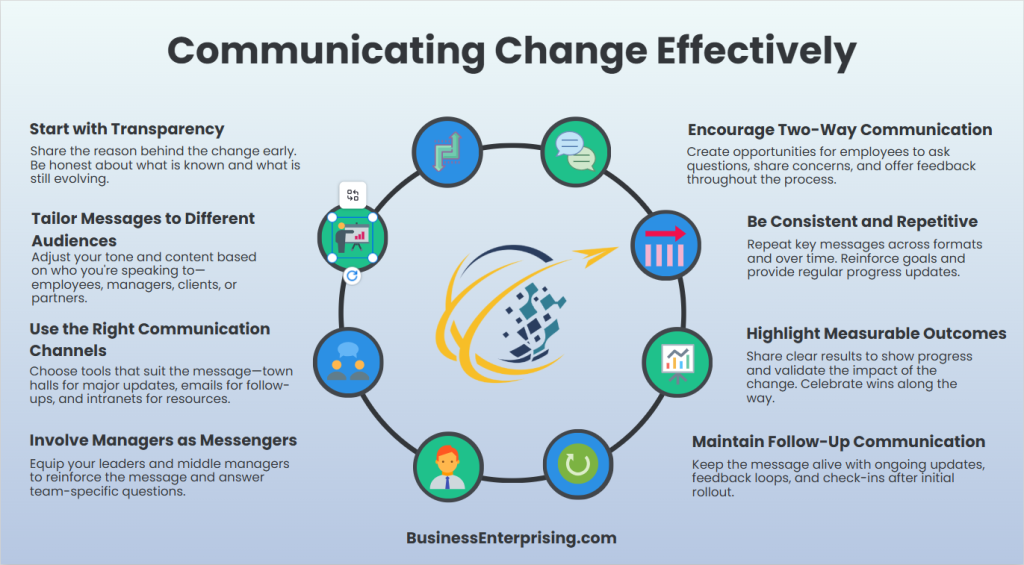
Change also requires consistency. It’s not enough to announce a decision and move on. People need reminders, updates, and proof that progress is happening. Therefore, following up reinforces the message and keeps people focused on shared goals. It also provides a chance to adjust plans based on feedback. Additionally, communication should go both ways. You need to create space for people to ask questions, raise concerns, and share suggestions. This gives your team a sense of ownership and allows you to uncover risks before they become issues. When people feel heard, they are more likely to support change and stay committed.
By focusing on clear and consistent communication, you reduce resistance and improve outcomes. You also build stronger relationships throughout your company. That kind of trust matters, especially when change brings uncertainty. Clear communication gives people the tools they need to move forward with confidence.
The Importance of Transparent and Timely Communication
Transparent and timely communication is essential during organizational change. Early, honest communication builds trust and reduces resistance among employees. When you share information openly, employees feel valued and informed. This approach minimizes uncertainty and fosters a sense of security. Consequently, employees are more likely to support the change. According to experts, transparent communication helps dispel rumors and address misconceptions. Additionally, it mitigates uncertainty by providing accurate information about the change process.
Timely communication also plays a critical role in change management. By addressing concerns promptly, you prevent the spread of misinformation. This proactive approach demonstrates leadership’s commitment to openness. As a result, employees are more likely to engage positively with the transition. Furthermore, timely updates keep everyone aligned with organizational goals. Therefore, understanding how to communicate change effectively is crucial for a smooth transition.
Moreover, transparent communication encourages employee participation. When employees understand the rationale behind changes, they feel empowered. This empowerment leads to increased commitment and motivation. Additionally, involving employees in the process can uncover valuable insights. These contributions can enhance the effectiveness of the change initiative. Ultimately, fostering a culture of openness benefits both the organization and its members.
Tailoring Messages to Different Audiences
Tailoring your communication style and content to fit employees, leadership, clients, and stakeholders is essential for effective change management. Understanding the unique needs and preferences of each audience ensures your message resonates and achieves its intended impact. When communicating with employees, adopt a clear and empathetic tone. They are directly affected by organizational changes and may have concerns about job security or workflow alterations. Providing detailed information and addressing their questions fosters trust and reduces anxiety. Encouraging feedback and creating open dialogue channels can also enhance engagement.
For leadership, focus on strategic implications and high-level overviews. Leaders are interested in how changes align with organizational goals and affect performance metrics. Presenting concise data, projected outcomes, and alignment with the company’s vision helps them make informed decisions. Utilizing visuals like charts or graphs can effectively convey complex information.
Clients require assurance that changes will not negatively impact the products or services they receive. Communicate benefits, timelines, and any adjustments they might experience. Maintaining a professional and reassuring tone preserves client confidence. Personalizing messages to address specific client concerns demonstrates attentiveness and commitment.
Stakeholders, such as investors or partners, need to understand the broader impact of changes. Highlight financial projections, market positioning, and long-term benefits. Being transparent about potential risks and mitigation strategies builds credibility. Regular updates and consistent messaging keep stakeholders informed and engaged.
Adapting your communication approach to each audience is a fundamental aspect of how to communicate change effectively. By considering their perspectives and priorities, you enhance understanding, foster collaboration, and facilitate smoother transitions during organizational changes.
Using the Right Communication Channels
Selecting the appropriate communication channels is essential for effectively conveying change-related messages within an organization. The choice of medium can significantly impact how information is received and acted upon.
Face-to-face meetings, such as staff or town hall gatherings, offer rich, immediate interactions. These settings allow for real-time feedback, addressing concerns promptly. They also foster a sense of community and shared purpose among employees.
Emails serve as efficient tools for distributing detailed information. They provide a written record that recipients can reference later. However, emails lack immediate feedback and may not fully convey tone or urgency.
Intranets or dedicated microsites centralize information about organizational changes. They act as repositories for updates, FAQs, and resources, ensuring consistent messaging. Employees can access these platforms at their convenience, promoting self-service and continuous learning.
Instant messaging platforms facilitate quick, informal communication. They are ideal for addressing immediate questions or clarifications. However, they may not be suitable for conveying complex or sensitive information.
Selecting the right channel depends on the message’s complexity and the audience’s needs. For instance, announcing a major restructuring might warrant a town hall meeting, followed by detailed emails and intranet updates. Conversely, minor procedural changes could be communicated via email or instant messaging.
Understanding how to communicate change effectively involves not only crafting clear messages but also choosing the appropriate platforms for dissemination. By aligning the communication medium with the message’s nature and the audience’s preferences, organizations can enhance understanding, reduce resistance, and foster a smoother transition during periods of change.
Involving Leadership and Middle Management
Involving leadership and middle management is essential for successful organizational change. Managers serve as change ambassadors, influencing team buy-in and morale. Their active participation can significantly affect the outcome of change initiatives.
Managers bridge the gap between top leadership and frontline employees. They interpret strategic decisions and convey them in relatable terms. This translation helps employees understand the change’s purpose and benefits. Consequently, it fosters acceptance and reduces resistance. Moreover, managers’ support directly impacts team morale. When leaders endorse change, employees feel more secure. This endorsement demonstrates confidence in the organization’s direction. Additionally, it encourages a positive attitude toward the transition.
Managers also play a crucial role in addressing concerns. They provide a platform for open dialogue, allowing employees to express fears. By acknowledging these feelings, managers build trust. This trust is vital for maintaining productivity during change. Furthermore, involving managers in planning ensures practical perspectives. They offer insights into potential challenges and solutions. Their involvement leads to more realistic strategies. Consequently, it increases the likelihood of successful implementation.
Understanding how to communicate change effectively involves leveraging managers’ influence. Their active support and engagement are pivotal. By empowering them as change ambassadors, organizations can navigate transitions more smoothly.
Encouraging Two-Way Communication and Feedback
Encouraging two-way communication and feedback is essential during organizational change. Creating space for questions, concerns, and suggestions improves clarity and engagement. This approach fosters trust and collaboration within the team. Open dialogue allows employees to express their thoughts freely. This exchange helps address uncertainties promptly. Consequently, it reduces resistance to change. Employees feel valued when their opinions are heard. This inclusion boosts morale and commitment.
Implementing feedback mechanisms is crucial. Surveys and suggestion boxes encourage input. Regular meetings provide platforms for discussion. These methods ensure continuous engagement. They also promote a culture of transparency. Managers should actively seek employee feedback. This practice demonstrates leadership’s openness. It also identifies potential issues early. Addressing concerns promptly enhances trust. Moreover, it facilitates smoother transitions.
Understanding how to communicate change effectively involves fostering two-way communication. By encouraging feedback, organizations can navigate change more successfully. This strategy leads to better outcomes for all stakeholders.
Reinforcing the Message with Consistency and Follow-Up
Reinforcing the message with consistency and follow-up is essential to making change stick. When you repeat key messages, employees are more likely to remember and understand them. Repetition builds clarity and reduces confusion. Additionally, consistent communication across teams builds alignment and trust in leadership. Everyone receives the same message, which lowers the risk of mixed signals.
Providing timely updates keeps people engaged and informed. As change unfolds, your team needs to know what’s happening and why it matters. Therefore, regular updates show that leadership is paying attention and keeping the process on track. They also help manage expectations and reduce uncertainty across departments.
Additionally, sharing measurable outcomes helps employees see the results of their efforts. Numbers and milestones create a sense of progress and reinforce the purpose behind the change. When teams see success, they feel encouraged to stay involved. Therefore, highlight achievements and recognize contributions. This boosts morale and supports continued participation.
Understanding how to communicate change effectively includes following through after the initial message. Change doesn’t happen in one conversation. It requires repetition, real updates, and proof that things are moving forward. By staying consistent and visible, you show your commitment and help your team adapt with confidence.
Conclusion
Mastering how to communicate change effectively is essential for organizational success. By implementing transparent communication, tailored messaging, appropriate channels, leadership involvement, two-way dialogue, and consistent reinforcement, you can navigate change more smoothly. These strategies not only reduce resistance but also foster a culture of trust and adaptability. As a result, your organization becomes better equipped to face future challenges and seize new opportunities.



